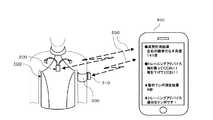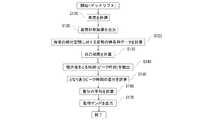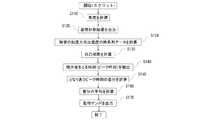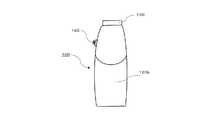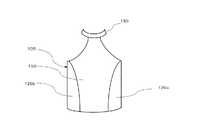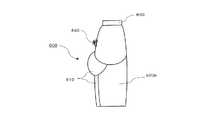JP2018201723A - Personal trainer suit, posture measurement device, posture measurement method and training shirt - Google Patents
Personal trainer suit, posture measurement device, posture measurement method and training shirtDownload PDFInfo
- Publication number
- JP2018201723A JP2018201723AJP2017108698AJP2017108698AJP2018201723AJP 2018201723 AJP2018201723 AJP 2018201723AJP 2017108698 AJP2017108698 AJP 2017108698AJP 2017108698 AJP2017108698 AJP 2017108698AJP 2018201723 AJP2018201723 AJP 2018201723A
- Authority
- JP
- Japan
- Prior art keywords
- training
- shirt
- posture
- user
- measuring device
- Prior art date
- Legal status (The legal status is an assumption and is not a legal conclusion. Google has not performed a legal analysis and makes no representation as to the accuracy of the status listed.)
- Granted
Links
Images
Landscapes
- Professional, Industrial, Or Sporting Protective Garments (AREA)
- Measurement Of The Respiration, Hearing Ability, Form, And Blood Characteristics Of Living Organisms (AREA)
Abstract
Translated fromJapaneseDescription
Translated fromJapanese本発明は、筋力トレーニングのためのウェアラブル型パーソナルトレーナースーツ、筋力トレーニングの参加者の姿勢を計測する装置及び方法、並びに、トレーニングシャツに関する。 The present invention relates to a wearable personal trainer suit for strength training, an apparatus and method for measuring postures of participants in strength training, and a training shirt.
超高齢化社会の日本では、医療機関や介護などの助けを受けずに自立して生活できる期間である「健康寿命」を平均寿命に近づけることが喫緊の課題である。健康を維持するためには、食事、睡眠、運動の生活習慣を適切に管理する必要がある。特に運動習慣については、加齢にともなう筋力低下を遅らせることができるという点から、筋力トレーニングを積極的に取り入れるべきである。 In Japan, a super-aging society, it is an urgent task to bring the “healthy life expectancy” close to the average life expectancy, which is a period in which people can live independently without the assistance of medical institutions or nursing care. In order to maintain health, it is necessary to properly manage the lifestyle of eating, sleeping and exercising. For exercise habits in particular, strength training should be actively adopted because it can delay the decline in muscle strength associated with aging.
近年、無人店舗型のジムの出店数が近年増加している。この形態のジムは従来の有人フィットネスクラブと同等かより低廉な価格で入会でき、会員であれば24時間入退店でき、トレーニング機器を自由に利用できることを特長としている。筋力トレーニングを行う機会は増えていると言えるが、その一方で、トレーニング参加者(以下、トレーニーと呼称)は筋力トレーニング時の姿勢やテンポを自分で管理する必要がある。 In recent years, the number of unmanned store-type gyms has increased in recent years. This form of gym is characterized by being able to join at a price that is the same or cheaper than a conventional manned fitness club, allowing members to enter and leave the store 24 hours a day, and using training equipment freely. While it can be said that the opportunities for strength training are increasing, on the other hand, training participants (hereinafter referred to as trainees) need to manage their posture and tempo during strength training themselves.
筋力トレーニングでは、怪我を防止しつつ、目的とする筋群に適切に負荷を与えて、最大のトレーニング効果を得ることが大切である。そのためにはトレーニング中の適切な姿勢および適切な動作のテンポを維持し続けることが必要である。 In strength training, it is important to obtain the maximum training effect by appropriately applying a load to the target muscle group while preventing injury. For this purpose, it is necessary to maintain an appropriate posture and an appropriate tempo during training.
これを達成するために、トレーニーは、トレーニング指導者(以下、トレーナーと呼称)の指導が得られる環境であれば、その模範動作を見て姿勢を学んだり、「胸を張って」、「肩を下げて」、「肘を引いて」といった口頭での指示を受けたりしながら動作に取り組むことができる。 In order to achieve this, trainees can learn postures by looking at their model movements, or “shoulder” or “shoulder” in an environment where the guidance of a training instructor (hereinafter referred to as a trainer) can be obtained. You can tackle the movement while receiving verbal instructions such as “lowering” and “pulling the elbow”.
しかし、(イ)そもそも無人店舗型ジムではトレーナーが不在であり、有人店舗型フィットネスでも常にトレーナーが側にいてフォームをチェックしているとは限らない(指導を受ける機会の欠如)、(ロ)胸を張るために力を入れる必要のある背面上部の筋群が、日常生活で意識する機会が少ない部位である(トレーニング経験が未熟)、(ハ)トレーニングセッションの後半で疲労が蓄積している(疲労という外部要因)、といった理由から不適切な姿勢をとってしまっている場合、トレーニーが自分で気付くことは困難である。 However, in the first place, there is no trainer in the unmanned store type gym, and even in the manned store type fitness, the trainer is not always on the side and checking the form (lack of opportunity to receive guidance), (b) The upper back muscle group that needs to be stressed to stretch the chest is a part where there are few opportunities to be aware in daily life (training experience is immature), (c) fatigue has accumulated in the second half of the training session It is difficult for trainees to notice for themselves if they have taken an inappropriate attitude (external factor of fatigue).
とりわけトレーニング初心者の場合、自分の姿勢が適切か否かを自分で判断することは現実的ではない。 Especially for training beginners, it is not realistic to determine whether or not one's posture is appropriate.
一人のトレーニーに対して一人のトレーナーが専属で対応するパーソナルトレーナー・サービスを利用すれば、不適切な姿勢を回避できると期待できる。しかしながら、一般にパーソナルトレーナーの料金は高額であり、誰もが利用できるものとは言い難い。 It can be expected that an inappropriate posture can be avoided by using a personal trainer service that one trainer is dedicated to each trainee. However, personal trainers generally have a high fee, and it is hard to say that everyone can use them.
このため、トレーニーが正しくない姿勢でトレーニングを続けてしまった結果、効果が得られない、または、オーバーユースによる受傷に至る可能性もある。 For this reason, as a result of continuing training in an incorrect posture, the trainee may not be effective or may be injured by overuse.
特許文献1には、肩甲骨−胸筋(主に前鋸筋)を強化する筋力トレーニング機器の利用者に対し、「胸をはっているか」のフィードバックを提供する技術が開示されている。 Patent Document 1 discloses a technique for providing feedback on whether the user is wearing a chest to a user of a strength training device that strengthens the scapula-thoracic muscle (mainly the anterior saw blade).
しかしながら、筋力トレーニングには、「胸を張っていても、肩をすくめる」フォームは不適切な場合がある。このため、筋力トレーニングの効果が得にくく、また、怪我をする可能性がある。 However, for strength training, the “shrug shoulders even when chest is stretched” form may be inappropriate. For this reason, the effect of strength training is difficult to obtain, and there is a possibility of injury.
本発明は、このような課題に着目して鋭意研究され完成されたものであり、その目的は、筋力トレーニング機器の利用者が「胸をはり」かつ「肩をすくめない」姿勢であるかを計測することにある。 The present invention has been studied and completed by paying attention to such problems, and the purpose of the present invention is to determine whether the user of the strength training device is in a posture of “chest of chest” and “should not shrug the shoulder”. It is to measure.
上記課題を解決するために、本発明は、利用者の鎖骨の動きに連動する連動部材と、前記連動部材の動きを計測する計測装置と、前記計測器を前記利用者の前胸部に固定するシャツと、を備えるパーソナルトレーナースーツである。 In order to solve the above problems, the present invention provides an interlocking member that interlocks with the movement of a user's clavicle, a measuring device that measures the motion of the interlocking member, and the measuring instrument that is fixed to the front chest of the user. A personal trainer suit with a shirt.
本発明によれば、筋力トレーニング機器の利用者が「胸をはり」かつ「肩をすくめない」姿勢であるかを計測することができる。 ADVANTAGE OF THE INVENTION According to this invention, it can be measured whether the user of a muscular strength training apparatus is the posture which is "chest of chest" and "should not shrug."
図面を参照しながら本発明の実施の形態を説明する。なお、各図において共通する部分には同一の符号を付し、重複した説明は省略する。 Embodiments of the present invention will be described with reference to the drawings. In addition, the same code | symbol is attached | subjected to the common part in each figure, and the overlapping description is abbreviate | omitted.
筋力トレーニングを適切に行うためには、ユーザが「胸をはり」かつ「肩をすくめない」姿勢を維持している必要がある。「胸をはり」かつ「肩をすくめない」姿勢に関係する関節は、肩甲胸郭関節と胸鎖関節の2つである。 In order to perform strength training appropriately, the user needs to maintain the posture of “chest” and “should not shrug”. There are two joints related to the postures of “chest of chest” and “should not shrug”: scapulothoracic joint and sternoclavicular joint.
肩甲骨を覆う筋肉は運動中に変形し、肩甲骨の表面の皮膚も動き、不安定になる。このため、皮膚の外側から肩甲胸郭関節の動きを正確に計測することは難しい。 The muscle that covers the scapula deforms during exercise, and the skin on the surface of the scapula also moves and becomes unstable. For this reason, it is difficult to accurately measure the movement of the scapulothoracic joint from the outside of the skin.
一方、胸骨と鎖骨の場所を手で触ってみるとわかる通り、胸骨と鎖骨を覆う筋肉や皮下脂肪はほとんど無く、胸骨と鎖骨の表面の皮膚は安定している。このため、皮膚を介して、胸鎖関節の動きを計測することは可能である。 On the other hand, as you can see by touching the locations of the sternum and clavicle, there is almost no muscle or subcutaneous fat covering the sternum and clavicle, and the skin on the surface of the sternum and clavicle is stable. For this reason, it is possible to measure the movement of the sternoclavicular joint through the skin.
また、人体では、上下に伸びる胸骨の上端の左右に、胸鎖関節が配置している。この胸鎖関節を介して、左右の鎖骨は胸骨と接続している。鎖骨は胸鎖関節を中心に立体的に動くことができる。 In the human body, the sternoclavicular joints are arranged on the left and right of the upper end of the sternum that extends vertically. The left and right clavicles are connected to the sternum via the sternum joint. The clavicle can move three-dimensionally around the thoracic joint.
すなわち、鎖骨の動きは、胸鎖関節を支点として、人体に垂直な軸(頭から足にかけて)を中心に前後に回転する成分(巻き肩になる、又は、胸を張る)と、人体に水平な軸(胸から背中にかけて)を中心に上下に回転する成分(肩をすくめる、又は、肩を下げる)に分解することができる。そこで、本実施例では、鎖骨の動きを前後成分と上下成分に分解して計測することにする。 In other words, the movement of the clavicle is a component that rotates back and forth around the axis perpendicular to the human body (from the head to the foot) with the thoracic chain joint as a fulcrum (becomes a curly shoulder or stretches the chest) and is horizontal to the human body. It can be broken down into components (shrug shoulders or shoulders) that rotate up and down around a simple axis (from chest to back). Therefore, in this embodiment, the movement of the clavicle is measured by decomposing it into the front and rear components and the upper and lower components.
(パーソナルトレーナースーツ)
図1は、本発明の実施例1に係るパーソナルトレーナースーツの概略構成図である。パーソナルトレーナースーツ10は、筋力トレーニング機器の利用者(以下、ユーザと呼称)の胸の部分に密着するトレーニングシャツ100と、トレーニングシャツ100の前胸部に着脱自在な姿勢計測装置200を少なくとも備えている。また、パーソナルトレーナースーツ10は、アームバンド300と、アームバンドに着脱自在な上腕測定装置310もさらに備えていてもよい。(Personal trainer suit)
FIG. 1 is a schematic configuration diagram of a personal trainer suit according to a first embodiment of the present invention. The
(姿勢計測装置を取り付けた状態のトレーニングシャツ)
トレーニングシャツ100は、両袖が無く、左右の鎖骨部分が見えるくらいに両肩が露出している。また、トレーニングシャツ100は、左右の鎖骨部分が露出するように、伸縮しにくい生地でシャツの前面を形成されている前身頃110と、伸縮しやすい生地でシャツの両側面を形成されている側身頃120a、120bと、伸縮しやすい生地でシャツの襟を形成されている襟ぐり布130と、シャツの後面である後身頃(不図示)とからなる。ここで、前身頃110の前胸部には、後述する凸部(不図示)が配設されており、姿勢計測装置200を着脱自在にすることが可能になる。(Training shirt with posture measuring device attached)
The
前身頃110を伸縮しにくい生地を用いて形成したのは、姿勢計測装置200を前胸部に相当する部分に安定的に取り付ける必要があるからである。すなわち、トレーニング中に姿勢計測装置200が前胸部に固定されずに、ずれてしまうと、正確な姿勢計測ができなくなるからである。一方、左右の側身頃120a、120bと、襟ぐり布130を伸縮しやすい生地を用いて形成したのは、利用者がトレーニングシャツ100を着たり脱いだりすることをし易くするためである。さらに、襟ぐり布130に面ファスナー(不図示)が設けられていると、利用者はトレーニングシャツ100をより着脱しやすくなる。 The reason why the
後身頃(不図示)の生地としては、トレーニングシャツ100の着脱を考慮して伸縮しやすい生地を用いてもよい。また、前身頃110と同様に、伸縮しにくい生地を用いた場合、より姿勢計測装置200を前胸部に固定することが可能になる。 As the fabric of the back body (not shown), a fabric that can easily expand and contract in consideration of attachment / detachment of the
(姿勢計測装置の概要構成)
姿勢計測装置200は、トレーニングする時には、上述した通り、トレーニングシャツ100の前胸部に取り付けられる。そして、姿勢計測装置200の上面には2つの連結部材230a、230bの一端が接続しており、連結部材230a、230bそれぞれの他端には連動部材220a、220bが接続している。(Outline configuration of attitude measurement device)
At the time of training,
連動部材220a、220bは、半円筒の形状をしている。その外周面に連結部材230a、230bが接続している。一方、内周面は、トレーニングシャツ100から露出している利用者の鎖骨部分の皮膚を覆っている。内周面の直径は人間の鎖骨部分の一部を覆う程度であればよく、2cm程度である。また、連動部材220a、220b及び連結部材230a、230bは、プラスチック等の成形加工しやすい材料で作成してよい。 The interlocking
左右の連動部材230a、230bはそれぞれ左右の鎖骨の動きに連動することができる。そして、左右の連動部材230a、230bと姿勢計測装置200を連結している左右の連結部材230a、230bは、左右の鎖骨の動きを姿勢計測装置200に伝えている。姿勢計測装置200の詳細については後述する。 The left and right interlocking
(上腕測定装置の構成)
上腕測定装置310は、直方体の形状であり、高さ約5cm、幅約4cm、奥行き約3cmである。筐体はプラスチック等の成形加工しやすい材料で作成される。上腕測定装置310の筐体は、不図示であるが、情報処理を行うCPU(Central Processing Unit)ボードと、3軸の回転速度を検出し、3軸の加速度を検出し、及び3軸の地磁気を検出して絶対方向を検出する慣性計測ユニットと、各種機器に電源を供給するバッテリと、外部端末と無線通信する無線データ通信器とを内蔵している。(Configuration of upper arm measuring device)
The upper
アームバンド300は、その外周面に上腕測定装置310を取り付けることができる。また、アームバンド300には面ファスナー(不図示)が設けられており、ユーザは上腕測定装置310をその上腕に固定することができる。上腕測定装置310の具体的な測定方法については後述する。 The
(姿勢計測装置の詳細構成)
図2は、実施例1に係る姿勢計測装置210の模式図である。この図は、右側の鎖骨の動きをどのように計測しているかについて説明する。本実施例では、姿勢計測装置210が鎖骨の動きを計測するために、複数の部品を組合せている。このため、鎖骨の動きがどのように姿勢計測装置に伝わるかの特徴を際立だせるため、模式図を用いる。模式図のため、各部品の大きさ及び取付け位置が実際とは少し異なる点に留意していただきたい。(Detailed configuration of attitude measurement device)
FIG. 2 is a schematic diagram of the
ここで、符号として、3桁の数字の後に、1文字のアルファベットの小文字aが記されている部品群は、右側の鎖骨の動きを姿勢計測装置210へ伝達するための部品群であることを表している。つまり、反対側(左側)の鎖骨の動きを計測するためには、同様の部品群を用意する必要がある点に留意していただきたい。 Here, as a code, a component group in which a one-letter alphabet lowercase letter a is written after a three-digit number is a component group for transmitting the movement of the right clavicle to the
筋力トレーニング中の鎖骨の動きとして計測する必要があるものには、4つある。1つ目は、「肩をすくめる」であり、鎖骨の上方向の動きに相当する。2つ目は、「肩を下げる」であり、下方向の動きに相当する。3つ目は、「巻き肩になる」であり、前方向の動きに相当する。4つ目は、「胸を張る」であり、後ろ方向の動きに相当する。 There are four things that need to be measured as clavicle movement during strength training. The first is “shrug shoulder”, which corresponds to the upward movement of the clavicle. The second is “lower shoulder”, which corresponds to a downward movement. The third is “become a shoulder” and corresponds to a forward movement. The fourth is “stretching the chest”, which corresponds to a backward movement.
人体の右側の鎖骨の動きと連動する連動部材220aは、半円筒の形状をしており、その内周面には両面テープ225aの一方が張り付けてある。この両面テープ225aの他方を、右側の鎖骨部分の皮膚に張り付けることによって、連動部材220aは、鎖骨部分と密着・固定し、鎖骨の動きに連動することができる。 The interlocking
ここで、鎖骨部分の皮膚と連動部材220aとを密着させるために両面テープ225aを用いた理由は、簡易に密着でき、両面テープ225aの張替えが容易であるためである。例えば、ユーザが姿勢計測装置210を購入した場合、ユーザは筋力トレーニングをする度に両面テープ225aを張り替えることができ、衛生的である。また、ユーザがトレーニングジムの受付で姿勢計測装置210を借りる場合、トレーニング前に両面テープ225aを張り、トレーニング後に剥がすことによって、やはり衛生的に姿勢計測装置210を利用することができる。 Here, the reason why the double-
右側の鎖骨の動きに連動する連動部材220aは、その外周面で連結部材230aと接続している。そして、連結部材230aは、レバー232aと接続している。レバー232aは、縦部材242aの長手方向(縦軸)に対して、回転可能である。そして、縦部材の上端には1軸センサ240aが配設されている。この1軸センサ240aは、レバー232aの回転角度を計測できる。ここでは、1軸センサ240aとして、ポテンショメータを利用している。ポテンショメータは回転角度に比例した電圧を出力することができる。 The interlocking
電圧信号は1軸センサ240aに電気的に接続した信号線213aを経由して、信号端子216aから、筐体210内に入力される。筐体210は、不図示であるが、情報処理を行うCPU(Central Processing Unit)ボードと、3軸の回転速度を検出し、3軸の加速度を検出し、及び3軸の地磁気を検出して絶対方向を検出する慣性計測ユニットと、各種機器に電源を供給するバッテリと、外部端末と無線通信する無線データ通信器とを内蔵している。信号端子216aからの電圧信号は、CPUボードに入力され、CPUボードによって情報処理される。 The voltage signal is input from the
図2の点線の直線軸は、前方向は「巻き肩になる」を表している。この前方向の動きは、レバー232aの点線の回転軸の反時計回り(図2の「前」)の回転角度として計測可能である。 The dotted linear axis in FIG. 2 represents “become a shoulder” in the forward direction. This forward movement can be measured as the counterclockwise rotation angle ("front" in FIG. 2) of the dotted rotation axis of the
同様に、図2の点線の直線軸の後方向は「胸を張る」を表している。この後方向の動きは、レバー232aの点線の回転軸の時計回り(図2の「後ろ」)の回転角度として計測可能である。 Similarly, the backward direction of the dotted linear axis in FIG. 2 represents “stretch chest”. This backward movement can be measured as the rotation angle of the rotation axis of the dotted line of the
次に、「肩をすくめる」及び「肩を下げる」をどのように計測しているかについて説明する。筐体210の上面に固定されている支持部材217aは、横部材252aの一端(図2の奥側)を固定している。 Next, how to measure “shoulder shrug” and “lower shoulder” will be described. The
そして、縦部材242aは、横部材252aの長手方向(横軸)に対して回転可能である。また、レバー232aも、横部材252aの長手方向(横軸)に対して回転可能である。 The
図2の実線の直線軸は、上方向は「肩をすくめる」を表している。この上方向の動きは、レバー232aの上方向の動きとなり、縦部材242aの実線の回転軸の時計回り(図2の「上」)の回転角度として計測可能である。 The solid linear axis in FIG. 2 represents “shoulder shrug” in the upward direction. This upward movement becomes the upward movement of the
同様に、図2の実線の直線軸の下方向は「肩を下げる」を表している。この下方向の動きは、レバー232aの下方向の動きとなり、縦部材242aの実線の回転軸の反時計回り(図2の「下」)の回転角度として計測可能である。 Similarly, the downward direction of the linear axis of the solid line in FIG. 2 represents “lower shoulder”. This downward movement is a downward movement of the
横部材252aの他端(図2の手前側)には、もう一つの1軸センサ250aが配設されている。この1軸センサ250aは、横部材252aに対する縦部材242aの回転角度を計測できる。ここで、1軸センサ250aも、ポテンショメータを利用している。ポテンショメータは回転角度に比例した電圧を出力することができる。 Another
電圧信号は1軸センサ250aに電気的に接続した信号線214aを経由して、信号端子215aから、筐体210内に入力される。信号端子215aからの電圧信号は、同様に、CPUボードに入力され、CPUボードによって情報処理される。 The voltage signal is input into the
このようにして、姿勢計測装置200は、筋力トレーニング中の右側の鎖骨の4つの動きを電圧信号の入力として受け取ることができる。また、図2では不図示であるが、同様に、左側の鎖骨の4つの動きも電圧信号の入力として受け取ることができる。 In this way, the
(姿勢計測装置の裏面の構成)
図3は、実施例1に係る姿勢計測装置200の裏面図である。姿勢計測装置200の筐体210の裏面には、図1のトレーニングシャツ100と着脱自在な留め具260が設けられている。(Configuration of the back of the posture measuring device)
FIG. 3 is a rear view of the
留め具260の中央には凹部262が設けられている。また、留め具260の下側は開口しており、後述するトレーニングシャツ100の凸部が下から上にスライドして、凹部262と嵌め合うことが可能になる。 A
可動部材264a、264bは、留め具260内のばね(不図示)の力によって、留め具260の下側の開口から突出している。トレーニングシャツ100の凸部を留め具260の凹部262にスライドして嵌め合う際には、可動部材264a、264bはいったん縮まる。トレーニングシャツ100の凸部が留め具260の凹部262に完全に収まると、可動部材264a、264bは、再び留め具260の下側の開口から突出し、姿勢計測装置200はトレーニングシャツ100に固定される。 The
姿勢計測装置200をトレーニングシャツ100から外す場合、手で筐体210を抑え、上方向にスライドすれば、可動部材264a、264bが縮まることによって、トレーニングシャツ100の凸部と留め具260の凹部262が外れるようになる。 When the
留め具260は厚みがあるため、筐体210はトレーニングシャツ100に対して不安定になりやすい。このため、留め具260の高さと同じ高さの高さ調整部材266a、266bを留め具260の下に設けている。 Since the
(姿勢計測システム)
図4は、本発明の実施例1に係る姿勢計測システムの概略構成図である。トレーニングシャツ100に固定された姿勢計測装置200では、内蔵のCPUボード(不図示)が、図2で説明した通り、筋力トレーニング中の鎖骨の4つの動きを電圧信号の入力として受け取り、左右の鎖骨の動きを計測し、無線データ通信器(不図示)から無線通信500を介して、スマートフォン等の携帯端末400に送信する。(Attitude measurement system)
FIG. 4 is a schematic configuration diagram of the attitude measurement system according to the first embodiment of the present invention. In the
携帯端末400のディスプレイは、姿勢計測結果及びトレーニングアドバイスを表示することができる。図4に表示している、姿勢計測結果「左右の鎖骨のなす角度は141度」及びトレーニングアドバイス「胸を張ってください! 肩を下げてください!」は、携帯端末400に標準搭載されているスピーカーから音声出力してもよい。また、後述する動作テンポ測定結果及びそのトレーニングアドバイスを表示または音声出力してもよい。 The display of the
ユーザは、姿勢計測結果及びトレーニングアドバイス等をするアプリケーションソフトウェアを携帯端末400に予めダウンロードしておくことによって、筋力トレーニング中の自分の姿勢やトレーニングアドバイスについてフィードバックを受けることができる。 The user can receive feedback on his / her posture and training advice during strength training by downloading application software for performing posture measurement results and training advice to the
(姿勢計測方法及び動作テンポの測定方法)
図5は、本発明の実施例1に係る姿勢計測方法のメインフローチャートである。ユーザは、まず、トレーニング種目を設定する(S10)。姿勢計測装置200には、トレーニング種目設定用のスイッチ(不図示)が、例えば、筐体(図2の210)の前面に設けられている。このスイッチをユーザが操作することによって、様々な種類のトレーニング姿勢を計測することが可能となる。ここでは、一例として、上腕が動く種目(S20)、デッドリフト(S30)、スクワット(S40)の場合について、トレーニング姿勢を計測する方法及びその動作テンポの測定方法を説明する。(Attitude measurement method and motion tempo measurement method)
FIG. 5 is a main flowchart of the attitude measurement method according to the first embodiment of the present invention. First, the user sets a training item (S10). In the
図6乃至図8は、本発明の実施例1に係る姿勢計測方法のサブフローチャートであり、それぞれ、上腕が動く種目の場合、デッドリフトの場合、及び、スクワットの場合のサブフローチャートを示している。基本的な処理の流れは同じであるが、後述する「自己相関処理」に入力するデータを替えることによって、様々なトレーニング種目に対応することが可能になる。 FIGS. 6 to 8 are sub-flowcharts of the posture measurement method according to the first embodiment of the present invention, and show sub-flowcharts for the case where the upper arm moves, the case of deadlift, and the case of squat, respectively. . Although the basic processing flow is the same, it is possible to deal with various training events by changing data input to “autocorrelation processing” described later.
まず、図6を参照して、上腕が動く種目の場合について説明する。姿勢計測装置200は、上述した通り、鎖骨の動きを回転角度として計測する(S110)。その回転角度に基づく姿勢計測結果を携帯端末400に無線送信し、携帯端末400は姿勢計測結果をユーザに表示又は音声で出力する(S120)。この姿勢計測結果には、図4で説明したトレーニングアドバイスも含まれる。 First, a case where the upper arm moves will be described with reference to FIG. As described above, the
次に、動作テンポの測定について説明する。姿勢計測装置200は、上述した通り、慣性計測ユニット及びCPUボード(共に不図示)を内蔵している。 Next, measurement of the operation tempo will be described. As described above, the
筋力トレーニングがラットプルダウン、ベンチプレス、や、サイドレイズ等の上腕が動く種目の場合、胸骨と上腕骨の相対角度の時系列データを計算する必要がある。図6の場合、胸骨に相当する位置に取り付けた姿勢計測装置200に内蔵されている慣性計測ユニット及びCPUボード、並びに、腕に取り付けた上腕測定装置310の慣性計測ユニット及びCPUボード(共に不図示)も用いることによって、後述するように、胸骨と上腕骨の相対角度の時系列データを計算することが可能となる(S122)。 When the strength training is an event in which the upper arm moves such as a rat pull-down, bench press, or side raise, it is necessary to calculate time series data of the relative angle between the sternum and the humerus. In the case of FIG. 6, the inertial measurement unit and CPU board built in the
肘を引く動きのテンポは、上腕骨の胸骨に対する相対姿勢によって求めることが可能になる。つまり、姿勢計測装置200の慣性計測ユニットが胸骨の姿勢を計測し、上腕測定装置310の慣性計測ユニットが上腕骨の姿勢を計測し、両方の計測結果を携帯端末400に送信する。 The tempo of pulling the elbow can be obtained from the relative posture of the humerus with respect to the sternum. That is, the inertial measurement unit of the
そして、上述したアプリケーションソフトウェアを予めダウンロードした携帯端末400が、受信した両方の計測結果をソフトウェア処理することによって、図6の胸骨と上腕骨の相対角度の時系列データに変換し(S122)、その自己相関を計算し(S130)、その極大値をとる時刻(ピーク時刻)を抽出し(S140)、となりあうピーク時刻の差分(差分時間)を計算し(S150)、差分時間の平均を計算し(S160)、腕が動く筋力トレーニング種目の動作テンポを出力する(S170)。 Then, the
このようにして、携帯端末400は、図4に示す通り、動作テンポ測定結果「4秒」、トレーニングアドバイス「適切なテンポです!」をユーザに向けて画面表示や音声で出力することが可能になる。 In this way, as shown in FIG. 4, the
本実施例では、胸骨及び上腕骨のデータ(あるいは、鎖骨及び上腕骨のデータ)を利用することによって、厳密な測定が難しい肩甲骨及び上腕骨の相対姿勢を計測しなくても、トレーニング動作のテンポを推定することが十分可能になる。 In this embodiment, by using the data of the sternum and the humerus (or the data of the clavicle and the humerus), it is possible to perform the training operation without measuring the relative posture of the scapula and the humerus, which is difficult to measure accurately. It becomes possible to estimate the tempo sufficiently.
次に、図7を参照して、デッドリフトの場合について説明する。姿勢計測装置200が回転角度を計測し(S110)、姿勢計測結果を出力する(S120)点は、図6と同じである。 Next, the case of deadlift will be described with reference to FIG. The point that the
デッドリフトの場合、胸骨に相当する位置に取り付けた姿勢計測装置200に内蔵されている慣性計測ユニット及びCPUボードが、胸骨の絶対空間に対する姿勢の時系列データを計算する(S123)点が特徴である。その後の、自己相関の計算(S130)から動作テンポの出力(170)までの処理ステップは図6と同じであるため、図6の説明を参照していただきたい。 In the case of a deadlift, the inertial measurement unit and the CPU board built in the
続いて、図8を参照して、スクワットの場合について説明する。姿勢計測装置200が回転角度を計測し(S110)、姿勢計測結果を出力する(S120)点は、図6と同じである。 Next, the case of squats will be described with reference to FIG. The point that the
スクワットの場合、胸骨に相当する位置に取り付けた姿勢計測装置200に内蔵されている慣性計測ユニット及びCPUボードが、胸骨の鉛直方向の加速度の時系列データを計算する(S124)点が特徴である。その後の、自己相関の計算(S130)から動作テンポの出力(170)までの処理ステップは図6と同じであるため、図6の説明を参照していただきたい。 In the case of squats, the inertial measurement unit and CPU board built in the
なお、ユーザが上腕測定装置310を購入した場合、ユーザは筋力トレーニングをする度にアームバンド300を取り換え、洗濯することができ、衛生的である。また、ユーザがトレーニングジムの受付で上腕測定装置310を借りる場合、トレーニング前にアームバンド300を取付け、トレーニング後に取り外すことによって、やはり衛生的に上腕測定装置310を利用することができる。 In addition, when a user purchases the upper
上述した図4乃至図8の説明では、姿勢計測装置200及び上腕測定装置310は直接、携帯端末400へ無線通信を行っている。しかしながら、本実施例は、これに限られたものではない。例えば、姿勢計測装置200及び上腕測定装置310はそれぞれの計測結果及び測定結果をクラウドサーバ(不図示)に無線通信で個別に送信し、クラウドサーバ(不図示)が上述した計算をすることによって、姿勢計測結果及びそのトレーニングアドバイス、並びに、動作テンポ測定結果及びそのトレーニングアドバイスをクラウドサーバ(不図示)から携帯端末400へ送信してもよい。 In the description of FIGS. 4 to 8 described above, the
また、姿勢計測装置200及び上腕測定装置310が、上述した計算も行い、さらにスピーカ(不図示)を有する場合には、携帯端末400やクラウドサーバ(不図示)を用いずに、姿勢計測結果及びそのトレーニングアドバイス、並びに、動作テンポ測定結果及びそのトレーニングアドバイスをスピーカ(不図示)から音声出力し、ユーザに伝えてもよい。 In addition, when the
(姿勢計測装置を外した状態のトレーニングシャツ)
図1では、姿勢計測装置200を取り付けた状態のトレーニングシャツ100の正面について説明した。ここでは、姿勢計測装置200を外した状態のトレーニングシャツ100について説明する。(Training shirt with posture measuring device removed)
In FIG. 1, the front of the
このトレーニングシャツ100は男性用のシャツである。図9は、実施例1に係るトレーニングシャツ100の正面図である。図10は、実施例1に係るトレーニングシャツ100の側面図である。図11は、実施例1に係るトレーニングシャツ100の背面図である。 This
トレーニングシャツ100は、両袖が無く、左右の鎖骨部分が見えるくらいに両肩が露出している。また、トレーニングシャツ100は、左右の鎖骨部分が露出するように、伸縮しにくい生地でシャツの前面を形成されている前身頃110と、伸縮しやすい生地でシャツの両側面を形成されている側身頃120a、120bと、伸縮しやすい生地でシャツの襟を形成されている襟ぐり布130と、前身頃110の前胸部に配設された凸部140と、伸縮しにくい生地でシャツの後面である後身頃150とからなる。 The
凸部140は、トレーニングシャツ100の前胸部に相当する部分に設けられていると説明したが、具体的には、左右の胸鎖関節の動きを制約しない程度に胸骨の上側に設けることが望ましい。このように設置することによって、図1に示した連結部材230a、230bの長さを最小限にすることができ、姿勢計測装置200を小さくまとめることができるからである。 Although it has been described that the
凸部140が、図3に示した留め具260の凹部262と着脱自在に嵌め合うことによって、姿勢計測装置200をトレーニングシャツ100に取り付けたり、外したりすることが可能になる。 By fitting the
ここで、トレーニングシャツ100と姿勢計測装置200とを着脱自在にするための一例として、凸部140と、留め具260の凹部262とを説明したが、本実施例はこれに限定されるものではない。例えば、トレーニングシャツ100側に凹部を設け、留め具260側に凸部を設けてもよい。 Here, as an example for making the
その他には、一対の面ファスナー(不図示)の一方をトレーニングシャツ100に設け、この面ファスナーの他方を姿勢計測装置200に設けてもよい。このように、一対の凹部及び凸部や、一対の面ファスナーのように、一対の着脱自在な部材を用いることによって、姿勢計測装置200をトレーニングシャツ100に着脱自在にすることが可能になる。 In addition, one of a pair of hook-and-loop fasteners (not shown) may be provided in the
(効果)
本実施例のパーソナルトレーナースーツによれば、トレーニングシャツの前胸部分に取り付けられた姿勢計測装置が左右の鎖骨の動きを計測しているため、筋力トレーニング中の姿勢が「胸をはり」かつ「肩をすくめない」フォームであるかを計測することができる。(effect)
According to the personal trainer suit of the present embodiment, the posture measuring device attached to the front chest part of the training shirt measures the movements of the left and right clavicles, so that the posture during strength training is “chestful” and “ It is possible to measure whether the form is "should not shrug."
本実施例の姿勢計測装置によれば、筋力トレーニング中の左右の鎖骨の動きに連動した回転角度を計測することができる。 According to the posture measuring apparatus of the present embodiment, it is possible to measure the rotation angle that is linked to the movement of the left and right clavicles during muscle strength training.
本実施例の姿勢計測システムによれば、姿勢計測装置の計測結果である「胸をはり」かつ「肩をすくめない」フォームであるかについて携帯端末を介して、筋力トレーニング中のユーザにフィードバックすることができる。また、姿勢計測装置に内蔵した慣性計測ユニットによって、筋力トレーニングの動作テンポについてもユーザにフィードバックすることができる。 According to the posture measurement system of the present embodiment, a feedback is sent to the user during the strength training via the portable terminal as to whether the form is a measurement result of the posture measurement device, ie, “chest measurement” and “should not shrug”. be able to. In addition, an inertial measurement unit built in the posture measuring device can provide feedback to the user regarding the operation tempo of strength training.
さらに、上腕測定装置が本実施例の姿勢計測システムに含まれている場合、上腕測定装置に内蔵した慣性計測ユニットの情報も用いることによって、上腕が動く筋力トレーニング種目についても動作テンポをユーザにフィードバックすることができる。 Furthermore, when the upper arm measurement device is included in the posture measurement system of the present embodiment, the information on the inertial measurement unit built in the upper arm measurement device is also used to feed back the operation tempo to the user for the strength training item in which the upper arm moves. can do.
本実施例のトレーニングシャツによれば、左右の鎖骨の動きを計測する姿勢計測装置を前胸部に相当する部分に安定的に取り付けることができる。これによって、ユーザが激しい動きをしても、姿勢計測装置が筋力トレーニングの姿勢を正確に計測することができる。また、トレーニングシャツは姿勢計測装置から着脱自在なため、洗濯することができ、衛生面で優れている。 According to the training shirt of the present embodiment, the posture measuring device that measures the movement of the left and right clavicles can be stably attached to the portion corresponding to the front chest. As a result, even if the user moves vigorously, the posture measuring device can accurately measure the posture of muscle strength training. Moreover, since the training shirt is detachable from the posture measuring device, it can be washed and is excellent in hygiene.
実施例1のトレーニングシャツ100は、男性用のシャツであるが、実施例2では、女性用のシャツについて説明する。 Although the
図12は、実施例2に係るトレーニングシャツ600の正面図である。図13は、実施例2に係るトレーニングシャツ600の側面図である。図14は、実施例2に係るトレーニングシャツ600の背面図である。 FIG. 12 is a front view of a
トレーニングシャツ600は、両袖が無く、左右の鎖骨部分が見えるくらいに両肩が露出している。また、トレーニングシャツ600は、左右の鎖骨部分が露出するように、伸縮しにくい生地でシャツの前面を形成されている前身頃610と、伸縮しやすい生地でシャツの両側面を形成されている側身頃620a、120bと、伸縮しやすい生地でシャツの襟を形成されている襟ぐり布630と、前身頃610の前胸部に配設された凸部640と、伸縮しにくい生地でシャツの後面である後身頃650とからなる。 The
女性用の前身頃610は、図9に示す男性用の前身頃110と異なり、胸の部分が立体的である。図12では、立体的な構成であることを点線で示している。一方、実線は各身頃の区分を表している。すなわち、前身頃610は、襟ぐり布630の下から、凸部640が取り付けられている部分、胸の立体的な部分、及び、お腹の部分で構成されている。 Unlike the
女性用の前身頃610のお腹の部分は男性用の前身頃110よりも横に広く、図13の側面図からも少し見える点が、男性用の前身頃110と異なる点でもある(男性用のトレーニングシャツの側面図である図10を参照)。このように、女性用の前身頃610のお腹の部分を広くしたのは、胸の部分を立体的に形成したため、激しい運動をしても、凸部640が安定的に固定されるようにするためである。 The stomach part of the female
その他の構成については、男性用のトレーニングシャツ100と同様であるため、その説明を参照していただきたい。 Other configurations are the same as those of the men's
(効果)
本実施例のトレーニングシャツによれば、女性も、男性と同様、左右の鎖骨の動きを計測する姿勢計測装置を前胸部に相当する部分に安定的に取り付けることができる。これによって、女性のユーザが激しい動きをしても、姿勢計測装置が筋力トレーニングの姿勢を正確に計測することができる。また、トレーニングシャツは姿勢計測装置から着脱自在なため、洗濯することができ、衛生面で優れている。(effect)
According to the training shirt of the present embodiment, a woman can stably attach a posture measuring device that measures the movements of the left and right clavicles to a portion corresponding to the front chest part, similarly to a man. Thereby, even if a female user makes a violent movement, the posture measuring device can accurately measure the posture of strength training. Moreover, since the training shirt is detachable from the posture measuring device, it can be washed and is excellent in hygiene.
以上、本発明の実施例(変形例を含む)について説明してきたが、これらのうち、2つ以上の実施例を組み合わせて実施しても構わない。あるいは、これらのうち、1つの実施例を部分的に実施しても構わない。さらには、これらのうち、2つ以上の実施例を部分的に組み合わせて実施しても構わない。 As mentioned above, although the Example (including a modification) of this invention has been described, you may implement combining two or more Examples among these. Or you may implement one Example partially among these. Furthermore, among these, two or more embodiments may be partially combined.
例えば、本発明でいう筋力トレーニングには、ウェイトトレーニングのみならず、ランニング等のウェイト機器を用いない運動も含まれる。また、日常生活での姿勢を計測することにも適用でき、生活・福祉・ヘルスケア全般に適用することが可能である。 For example, the strength training in the present invention includes not only weight training but also exercise that does not use weight equipment such as running. It can also be applied to measuring postures in daily life, and can be applied to general life, welfare and healthcare.
本発明は、上記発明の実施例の説明に何ら限定されるものではない。特許請求の範囲の記載を逸脱せず、当業者が容易に想到できる範囲で種々の変形態様もこの発明に含まれる。例えば、姿勢計測装置、上腕測定装置、及び、携帯端末を防水仕様にすれば、陸上のトレーニングに限らす、水泳など水中でのトレーニングにも適用できる。 The present invention is not limited to the description of the embodiments of the invention. Various modifications may be included in the present invention as long as those skilled in the art can easily conceive without departing from the description of the scope of claims. For example, if the posture measuring device, the upper arm measuring device, and the portable terminal are made waterproof, the present invention can be applied to training in water such as swimming as well as training on land.
10 パーソナルトレーナースーツ
100、600 トレーニングシャツ
110、610 前身頃
120a、120b、620a、620b 側身頃
130、630 襟ぐり布
140、640 凸部
150、650 後身頃
200 姿勢計測装置
210 筐体
213a、214a 信号線
215a、216a 信号端子
217a 支持部材
220a、220b 連動部材
225a 両面テープ
230a、230b 連結部材
232a レバー
240a、250a 1軸センサ
242a 縦部材
252a 横部材
260 留め具
262 凹部
264a、264b 可動部材
266a、266b 高さ調整部材
300 アームバンド
310 上腕測定装置
400 携帯端末
500 無線通信
10
Claims (14)
Translated fromJapanese前記連動部材の動きを計測する計測装置と、
前記計測装置を前記利用者の前胸部に固定するシャツと、
を備えるパーソナルトレーナースーツ。An interlocking member that interlocks with the movement of the user's clavicle;
A measuring device for measuring the movement of the interlocking member;
A shirt for fixing the measuring device to the front chest of the user;
Personal trainer suit with.
前記連動部材の動きを計測する計測装置と、
を備える姿勢計測装置。An interlocking member that interlocks with the movement of the user's clavicle;
A measuring device for measuring the movement of the interlocking member;
An attitude measurement device comprising:
前記計測した動きに基づき、前記利用者の姿勢計測結果及びトレーニングアドバイスを出力する出力ステップと、
を備える姿勢計測方法。A measurement step for measuring the movement of the user's clavicle;
An output step for outputting the posture measurement result of the user and training advice based on the measured movement;
An attitude measurement method comprising:
前記計測装置の計測結果に基づき、前記利用者の姿勢計測結果及びトレーニングアドバイスを出力する姿勢計測システム。A personal trainer having an interlocking member that interlocks with the movement of the user's clavicle, a measuring device that measures the motion of the interlocking member and can communicate wirelessly, and a shirt that fixes the measuring device to the front chest of the user A posture measurement system comprising a suit,
An attitude measurement system that outputs an attitude measurement result and training advice of the user based on a measurement result of the measurement device.
前記携帯端末は、前記計測装置の計測結果に基づき、前記利用者の姿勢計測結果及びトレーニングアドバイスを出力する請求項7に記載の姿勢計測システム。A portable terminal capable of wireless communication;
The posture measurement system according to claim 7, wherein the portable terminal outputs a posture measurement result and training advice of the user based on a measurement result of the measurement device.
前記携帯端末は、前記慣性計測ユニットの計測結果に基づく、前記利用者の動作テンポ及びトレーニングアドバイスを出力する請求項8に記載の姿勢計測システム。The measuring device has an inertial measurement unit,
The posture measurement system according to claim 8, wherein the portable terminal outputs an operation tempo and training advice of the user based on a measurement result of the inertial measurement unit.
前記携帯端末は、前記上腕測定装置と無線通信可能であり、前記の他の慣性計測ユニットの計測結果に基づく、前記利用者の動作テンポ及びトレーニングアドバイスを出力する請求項9に記載の姿勢計測システム。It has another inertial measurement unit that measures the movement of the user's upper arm, and further includes an upper arm measurement device capable of wireless communication,
The posture measurement system according to claim 9, wherein the portable terminal is capable of wireless communication with the upper arm measurement device, and outputs the user's operation tempo and training advice based on a measurement result of the other inertial measurement unit. .
伸縮しやすい生地でシャツの両側面を形成されている側身頃と、
前記伸縮しやすい生地でシャツの襟を形成されている襟ぐり布と、
シャツの後面である後身頃と、
前記前身頃の前胸部に設けられた、一対の着脱自在な部材の一方と、を備えるトレーニングシャツであって、
前記一対の着脱自在な部材の他方を有する姿勢計測装置が鎖骨の動きを計測可能にするために、前記前身頃は左右の鎖骨部分が露出するように形成されているトレーニングシャツ。The front part of the front of the shirt is made of fabric that does not stretch easily,
Side body that is formed on both sides of the shirt with fabric that stretches easily,
A neckline cloth that is formed with a shirt collar with the stretchable fabric;
The back of the back of the shirt,
A training shirt provided with one of a pair of detachable members provided on the front chest of the front body,
A training shirt in which the front body is formed such that left and right clavicle portions are exposed so that the posture measuring device having the other of the pair of detachable members can measure the movement of the clavicle.
The training shirt according to claim 11, wherein the pair of detachable members are formed of hook-and-loop fasteners.
Priority Applications (1)
| Application Number | Priority Date | Filing Date | Title |
|---|---|---|---|
| JP2017108698AJP6900031B2 (en) | 2017-05-31 | 2017-05-31 | Personal trainer suit, posture measuring device, posture measuring method, and training shirt |
Applications Claiming Priority (1)
| Application Number | Priority Date | Filing Date | Title |
|---|---|---|---|
| JP2017108698AJP6900031B2 (en) | 2017-05-31 | 2017-05-31 | Personal trainer suit, posture measuring device, posture measuring method, and training shirt |
Publications (2)
| Publication Number | Publication Date |
|---|---|
| JP2018201723Atrue JP2018201723A (en) | 2018-12-27 |
| JP6900031B2 JP6900031B2 (en) | 2021-07-07 |
Family
ID=64954496
Family Applications (1)
| Application Number | Title | Priority Date | Filing Date |
|---|---|---|---|
| JP2017108698AActiveJP6900031B2 (en) | 2017-05-31 | 2017-05-31 | Personal trainer suit, posture measuring device, posture measuring method, and training shirt |
Country Status (1)
| Country | Link |
|---|---|
| JP (1) | JP6900031B2 (en) |
Families Citing this family (1)
| Publication number | Priority date | Publication date | Assignee | Title |
|---|---|---|---|---|
| KR102826817B1 (en)* | 2022-08-11 | 2025-06-30 | 주식회사 비플렉스 | An apparatus and method for fitness-tracking |
Citations (8)
| Publication number | Priority date | Publication date | Assignee | Title |
|---|---|---|---|---|
| JP2008503268A (en)* | 2004-06-18 | 2008-02-07 | ヴィーヴォメトリックス インコーポレイテッド | System and method for real-time physiological monitoring |
| US20110060215A1 (en)* | 2009-03-30 | 2011-03-10 | Tupin Jr Joe Paul | Apparatus and method for continuous noninvasive measurement of respiratory function and events |
| JP2013185277A (en)* | 2012-03-08 | 2013-09-19 | Nishi Sports:Kk | Wear for short-distance track race |
| US20130296661A1 (en)* | 2012-05-04 | 2013-11-07 | Pacesetter, Inc. | System and method for implanting a physiologic sensor assembly |
| JP2016034482A (en)* | 2014-07-31 | 2016-03-17 | セイコーエプソン株式会社 | Exercise analysis device, exercise analysis method, exercise analysis program, and exercise analysis system |
| WO2016092912A1 (en)* | 2014-12-11 | 2016-06-16 | ソニー株式会社 | Program and information processing system |
| JP2016158780A (en)* | 2015-02-27 | 2016-09-05 | カシオ計算機株式会社 | Riding posture evaluation device, riding posture evaluation method and program |
| WO2017029284A1 (en)* | 2015-08-14 | 2017-02-23 | Resmed Sensor Technologies Limited | Digital range gated radio frequency sensor |
- 2017
- 2017-05-31JPJP2017108698Apatent/JP6900031B2/enactiveActive
Patent Citations (8)
| Publication number | Priority date | Publication date | Assignee | Title |
|---|---|---|---|---|
| JP2008503268A (en)* | 2004-06-18 | 2008-02-07 | ヴィーヴォメトリックス インコーポレイテッド | System and method for real-time physiological monitoring |
| US20110060215A1 (en)* | 2009-03-30 | 2011-03-10 | Tupin Jr Joe Paul | Apparatus and method for continuous noninvasive measurement of respiratory function and events |
| JP2013185277A (en)* | 2012-03-08 | 2013-09-19 | Nishi Sports:Kk | Wear for short-distance track race |
| US20130296661A1 (en)* | 2012-05-04 | 2013-11-07 | Pacesetter, Inc. | System and method for implanting a physiologic sensor assembly |
| JP2016034482A (en)* | 2014-07-31 | 2016-03-17 | セイコーエプソン株式会社 | Exercise analysis device, exercise analysis method, exercise analysis program, and exercise analysis system |
| WO2016092912A1 (en)* | 2014-12-11 | 2016-06-16 | ソニー株式会社 | Program and information processing system |
| JP2016158780A (en)* | 2015-02-27 | 2016-09-05 | カシオ計算機株式会社 | Riding posture evaluation device, riding posture evaluation method and program |
| WO2017029284A1 (en)* | 2015-08-14 | 2017-02-23 | Resmed Sensor Technologies Limited | Digital range gated radio frequency sensor |
Non-Patent Citations (1)
| Title |
|---|
| KAZUNORI KIKUCHI AND KOICHI SAGAWA: "3D posture estimation of upper limb considering clavicle usinginertial sensor", MECHANICAL ENGINEERING JOURNAL, vol. 1, no. 1, JPN6021009070, ISSN: 0004464091* |
Also Published As
| Publication number | Publication date |
|---|---|
| JP6900031B2 (en) | 2021-07-07 |
Similar Documents
| Publication | Publication Date | Title |
|---|---|---|
| EP3297520B1 (en) | Devices for measuring human gait and related methods of use | |
| US9795337B2 (en) | System, apparatus, and method for promoting usage of core muscles and other applications | |
| US10352962B2 (en) | Systems and methods for real-time data quantification, acquisition, analysis and feedback | |
| US20220241643A1 (en) | Systems and methods for real-time data quantification, acquisition, analysis, and feedback | |
| US20180256939A1 (en) | Variable weight units, computing device kit applications, and method of use | |
| EP2220997A1 (en) | Device, system and method for monitoring motion sequences | |
| US20160310065A1 (en) | Spinal cord posture monitoring system in anterior/posterior and lateral directions | |
| WO2021032970A1 (en) | Joint motion capture | |
| US20200372825A1 (en) | Intelligent garment | |
| US20140194262A1 (en) | Electronic Exercise Monitor with Human Facsimile and Audible Feedback | |
| KR101656786B1 (en) | Core motion system combined with information technology | |
| US10405797B1 (en) | Wearable device and system for teaching core usage and related applications | |
| JP2011240047A (en) | Biological information detector and system and method for monitoring subject | |
| JP6900031B2 (en) | Personal trainer suit, posture measuring device, posture measuring method, and training shirt | |
| CN106455993A (en) | Wearable system for monitoring a swimmer's performance | |
| CN116212355B (en) | Fitness guidance system and fitness guidance method | |
| KR20190011864A (en) | Method for Rehabilitation Management using Assistant Device | |
| US9378656B2 (en) | Electronic exercise monitor with human facsimile and audible feedback | |
| WO2020007802A1 (en) | System for detection and kinematic monitoring of body movements in water, and relative method | |
| US20240335346A1 (en) | Motion assist device | |
| Mears | Technology in physical education article# 6 in a 6-part series: physical activity monitoring: gadgets and uses | |
| Kim et al. | Development of Smart Athleisure Fashion for Dumbbell Economy-Focused on the Analysis of Upper and Lower body muscle strength by angle | |
| CN212679985U (en) | Upper limb rehabilitation training device | |
| Pot | Designing and developing a haptic feedback wearable to improve motor task performance: A case study on the squat | |
| JP3193887U (en) | Stretch evaluation instrument |
Legal Events
| Date | Code | Title | Description |
|---|---|---|---|
| A621 | Written request for application examination | Free format text:JAPANESE INTERMEDIATE CODE: A621 Effective date:20200522 | |
| A977 | Report on retrieval | Free format text:JAPANESE INTERMEDIATE CODE: A971007 Effective date:20210305 | |
| A131 | Notification of reasons for refusal | Free format text:JAPANESE INTERMEDIATE CODE: A131 Effective date:20210312 | |
| A521 | Request for written amendment filed | Free format text:JAPANESE INTERMEDIATE CODE: A523 Effective date:20210507 | |
| TRDD | Decision of grant or rejection written | ||
| A01 | Written decision to grant a patent or to grant a registration (utility model) | Free format text:JAPANESE INTERMEDIATE CODE: A01 Effective date:20210519 | |
| A61 | First payment of annual fees (during grant procedure) | Free format text:JAPANESE INTERMEDIATE CODE: A61 Effective date:20210609 | |
| R150 | Certificate of patent or registration of utility model | Ref document number:6900031 Country of ref document:JP Free format text:JAPANESE INTERMEDIATE CODE: R150 | |
| R250 | Receipt of annual fees | Free format text:JAPANESE INTERMEDIATE CODE: R250 | |
| R250 | Receipt of annual fees | Free format text:JAPANESE INTERMEDIATE CODE: R250 |



